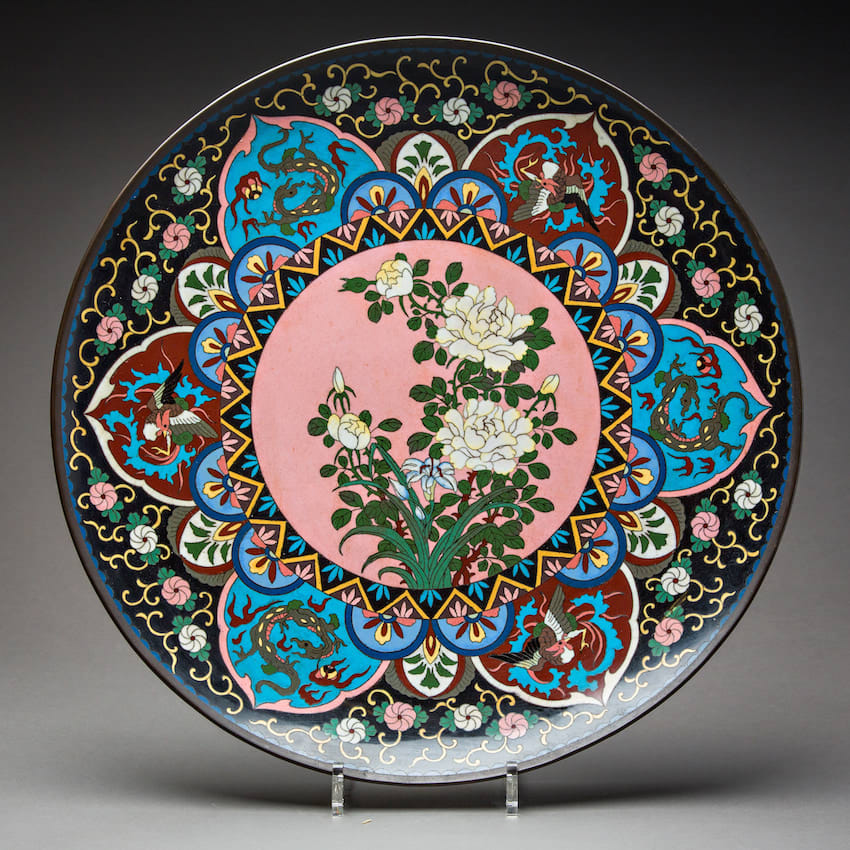Large cloisonné plate with curving lip and floral decoration
2.3 x 18
MS.1405
Jing Tai Lan (the Chinese for cloisonné) is a unique form of art that combines sculpture, painting, copper smithing and porcelain making. Its name originates from a careful pairing of...
Jing Tai Lan (the Chinese for cloisonné) is a unique form of art that combines sculpture, painting, copper smithing and porcelain making. Its name originates from a careful pairing of “Jing Tai,” the name of a Ming dynasty emperor during whose reign mass production of such articles began, and “Lan,” meaning blue, which is the background colour for most cloisonné goods. Cloisonné enamel techniques were originally brought from Persia to China’s Yunnan Province during the Yuan Dynasty. During the Ming dynasty, Persian techniques were then incorporated with the traditional, native techniques for metal inlaying and porcelain making, resulting in the birth of a new kind of cloisonné called Jing Tai Lan.
This particular cloisonné plate features a tremendous amount of hidden symbolism that lies behind the decorative beauty. Beginning with the stunning floral motifs, the small blue flower and buds against the light pink background are China’s prized day lilies, whose bloom only lasts one day. By contrast, the more robust flowering around the lilies are white roses, specifically the Chinese yueji, which are famous for the fact that they blossom almost every month of the year. For this reason, the Chinese rose is also known as ‘the eternal spring flower’ (changchunhua) and is thus a symbol of longevity. Though white traditionally represents passing and ghostliness in Chinese flower symbolism, it has been re-appropriated to signify eternality rather than ephemerality. Similarly, the surrounding pink represents life and celebration.
Along the dark rim of the plate, there are leafy interlacing scrolls bearing hibiscus in the same hues of white and pink. The most celebrated hibiscus in China is known as mufurong, which provides a rebus for ‘wealth and glory,’ and is famous for the fact that it is white when it opens in the morning but turns pink as the day fades. Together, the combination of rose with hibiscus suggests the phrase ‘changchun ronghua’: ‘May you have wealth, glory and a long life.’
Furthermore, dragons and phoenixes adorn alternating lotus petals that encircle the central roses. The dragon and the phoenix represent the height of power and auspiciousness in China. Emblematic of male prowess, strength and divine rule, the dragon symbolizes the Emperor of China and is ranked first among mythical beasts – believed to bring fertility to the land. The phoenix, on the other hand, represents female authority, benevolence and beauty, and is associated with the Empress of China. The phoenix appears during times of peace and prosperity; it is believed that when Confucius was born, the phoenix announced the emergence of the great man. The combination of dragon and phoenix is often seen at weddings, conveying blessings and good fortune.
This particular cloisonné plate features a tremendous amount of hidden symbolism that lies behind the decorative beauty. Beginning with the stunning floral motifs, the small blue flower and buds against the light pink background are China’s prized day lilies, whose bloom only lasts one day. By contrast, the more robust flowering around the lilies are white roses, specifically the Chinese yueji, which are famous for the fact that they blossom almost every month of the year. For this reason, the Chinese rose is also known as ‘the eternal spring flower’ (changchunhua) and is thus a symbol of longevity. Though white traditionally represents passing and ghostliness in Chinese flower symbolism, it has been re-appropriated to signify eternality rather than ephemerality. Similarly, the surrounding pink represents life and celebration.
Along the dark rim of the plate, there are leafy interlacing scrolls bearing hibiscus in the same hues of white and pink. The most celebrated hibiscus in China is known as mufurong, which provides a rebus for ‘wealth and glory,’ and is famous for the fact that it is white when it opens in the morning but turns pink as the day fades. Together, the combination of rose with hibiscus suggests the phrase ‘changchun ronghua’: ‘May you have wealth, glory and a long life.’
Furthermore, dragons and phoenixes adorn alternating lotus petals that encircle the central roses. The dragon and the phoenix represent the height of power and auspiciousness in China. Emblematic of male prowess, strength and divine rule, the dragon symbolizes the Emperor of China and is ranked first among mythical beasts – believed to bring fertility to the land. The phoenix, on the other hand, represents female authority, benevolence and beauty, and is associated with the Empress of China. The phoenix appears during times of peace and prosperity; it is believed that when Confucius was born, the phoenix announced the emergence of the great man. The combination of dragon and phoenix is often seen at weddings, conveying blessings and good fortune.
158
of
158
